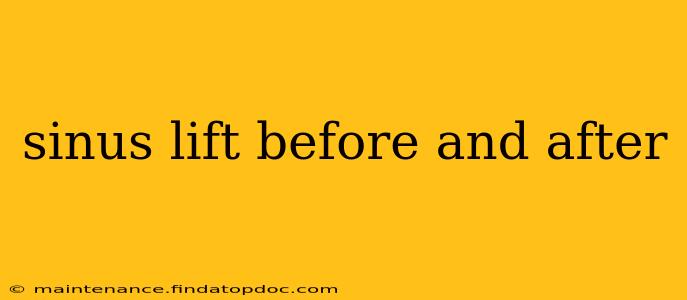A sinus lift, also known as a sinus augmentation, is a surgical procedure used to increase the bone volume in the upper jaw's posterior (back) region. This is crucial for individuals who need dental implants placed in this area, as insufficient bone height can prevent successful implant placement. Understanding the before and after aspects of this procedure is key to making an informed decision.
What Happens Before a Sinus Lift?
Before undergoing a sinus lift, you'll have a thorough consultation with your oral surgeon or periodontist. This consultation is vital for several reasons:
1. Assessing Bone Density and Sinus Health: The surgeon will conduct a comprehensive examination, including X-rays or 3D scans (like CBCT scans), to evaluate the amount of bone available in your upper jaw and the condition of your sinuses. This assessment determines the type of sinus lift needed and the feasibility of implant placement.
2. Medical History Review: You'll be asked about your medical history, including any allergies, medications you're taking, and previous surgeries. This is crucial to assess potential risks and complications.
3. Treatment Planning: Based on the assessment, the surgeon will create a personalized treatment plan, outlining the type of sinus lift (closed or open), the number of implants needed, and the expected recovery timeline.
4. Pre-operative Instructions: You will receive detailed instructions on preparing for the surgery, including dietary restrictions, medications to avoid, and post-operative care.
What Happens During a Sinus Lift?
There are two main types of sinus lifts:
1. Closed Sinus Lift: This less invasive technique involves lifting the sinus membrane using a small incision in the gum line. Bone grafting material is then inserted into the space created.
2. Open Sinus Lift: This more extensive procedure involves a larger incision in the gum line to provide better access to the sinus membrane. This technique is usually preferred when more bone augmentation is needed.
The actual surgery is performed under local anesthesia or sedation, and it typically takes around 30-60 minutes depending on the complexity.
What is the Recovery Process Like After a Sinus Lift?
Recovery time varies depending on the complexity of the procedure and individual healing rates. Common aspects include:
- Pain and Swelling: You can expect some pain and swelling in the area for the first few days. Pain medication can be prescribed to manage discomfort.
- Bleeding: Some minor bleeding is also normal, but excessive bleeding should be reported to your surgeon immediately.
- Dietary Restrictions: You'll likely need to follow a soft food diet for a while to allow the surgical site to heal properly.
- Follow-up Appointments: Regular follow-up appointments are crucial to monitor healing and ensure proper integration of the bone graft.
What Are the Potential Risks and Complications?
As with any surgical procedure, there are potential risks and complications associated with sinus lifts. These include:
- Sinus Infection: This is a relatively common risk, particularly after an open sinus lift. Antibiotics are usually prescribed to prevent infection.
- Damage to the Sinus Membrane: While rare, damage to the sinus membrane can occur during the procedure.
- Bone Graft Failure: In some cases, the bone graft may not integrate successfully, requiring further intervention.
- Nerve Damage: In rare instances, nerve damage can occur, leading to numbness or tingling in the area.
How Long Does It Take to Recover Before Dental Implants Can Be Placed?
The healing time required before implant placement depends on several factors, including the type of sinus lift performed, the amount of bone grafted, and the individual's healing response. It usually takes 4-6 months for the bone to properly heal and integrate before implants can be placed. This allows enough time for sufficient osseointegration (bone fusion to the implant).
What is the Long-Term Success Rate of Sinus Lifts?
With proper surgical technique and post-operative care, the long-term success rate of sinus lifts is high. Many patients successfully receive and maintain dental implants after undergoing this procedure. However, individual results may vary.
Can I Avoid a Sinus Lift?
In some cases, if sufficient bone height exists, a sinus lift may not be necessary for dental implant placement. However, if there is insufficient bone, a sinus lift is often essential for successful implant integration. This decision should be made based on a thorough evaluation by a qualified oral surgeon or periodontist.
This comprehensive overview should provide you with a clearer understanding of the sinus lift procedure, from before and after considerations to the potential benefits and risks. Remember to consult with a qualified dental professional for personalized advice and treatment planning.
